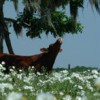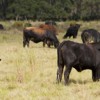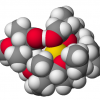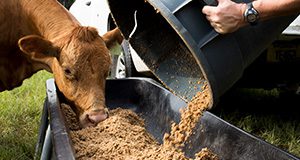The forage cattle consume as the bulk of their diet is often deficient in trace mineral concentrations. Cattle producers can choose from a number of different methods to provide supplemental trace minerals to cattle. This 3-page document discusses several common ways to provide trace mineral supplements as well as their advantages and disadvantages. Written by Matt Hersom and Todd Thrift, and published by the UF/IFAS Department of Animal Sciences, October 2018.
http://edis.ifas.ufl.edu/an348
Tag: Beef Cattle Nutrition
The Interaction of Nutrition and Health in Beef Cows
 In cattle, all physiological processes in the body, including the immune system, are influenced by the cattle’s nutritional status. Therefore, the past and present nutritional status serves as an immune function modulator in cattle that can influence the performance and reproduction of beef cattle. This 6-page fact sheet was written by Matt Hersom, and published by the UF Department of Animal Sciences, June 2014.
In cattle, all physiological processes in the body, including the immune system, are influenced by the cattle’s nutritional status. Therefore, the past and present nutritional status serves as an immune function modulator in cattle that can influence the performance and reproduction of beef cattle. This 6-page fact sheet was written by Matt Hersom, and published by the UF Department of Animal Sciences, June 2014.
http://edis.ifas.ufl.edu/an292
Understanding the Effects of Forage Composition and Structure in Ruminant Nutrition (AN288)
 Approximately 68% of the 16 million square miles of agricultural land worldwide is used for permanent pastures for livestock production. Fortunately, ruminants can convert plant matter that is inedible or of low nutritional value for monogastrics (i.e., swine or poultry) into calorically dense products of high nutritional value. However, the process of converting poor quality plant matter into useful nutrients for ruminants is complex. This 3-page fact sheet provides an overview and understanding of how forage composition and structure affect the nutritive value and nutrient availability to ruminants. Written by Kalyn M. Waters, Nicolas DiLorenzo, and G. Cliff Lamb, and published by the UF Department of Animal Sciences, March 2013.
Approximately 68% of the 16 million square miles of agricultural land worldwide is used for permanent pastures for livestock production. Fortunately, ruminants can convert plant matter that is inedible or of low nutritional value for monogastrics (i.e., swine or poultry) into calorically dense products of high nutritional value. However, the process of converting poor quality plant matter into useful nutrients for ruminants is complex. This 3-page fact sheet provides an overview and understanding of how forage composition and structure affect the nutritive value and nutrient availability to ruminants. Written by Kalyn M. Waters, Nicolas DiLorenzo, and G. Cliff Lamb, and published by the UF Department of Animal Sciences, March 2013.
http://edis.ifas.ufl.edu/an288
Application of Ionophores in Cattle Diets (AN285)
 Beef cattle producers should consider using ionophores to increase calf gain and gain efficiency in a cost-effective manner. Ionophores are feed additives used in cattle diets to increase feed efficiency and body weight gain. They are compounds that alter rumen fermentation patterns. Ionophores can be fed to any class of cattle and can be used in any segment of the beef cattle industry. Similar to many other feed additives, ionophores are fed in very small amounts and supplied via another feedstuff as carrier for intake. Ionophores decrease incidence of coccidiosis, bloat, and acidosis in cattle. This 4-page fact sheet was written by Matt Hersom and Todd Thrift, and published by the UF Department of Animal Sciences, December 2012.
Beef cattle producers should consider using ionophores to increase calf gain and gain efficiency in a cost-effective manner. Ionophores are feed additives used in cattle diets to increase feed efficiency and body weight gain. They are compounds that alter rumen fermentation patterns. Ionophores can be fed to any class of cattle and can be used in any segment of the beef cattle industry. Similar to many other feed additives, ionophores are fed in very small amounts and supplied via another feedstuff as carrier for intake. Ionophores decrease incidence of coccidiosis, bloat, and acidosis in cattle. This 4-page fact sheet was written by Matt Hersom and Todd Thrift, and published by the UF Department of Animal Sciences, December 2012.
http://edis.ifas.ufl.edu/an285
Strategies for Cost-Effective Supplementation of Beef Cattle (SSANS14/AN085)
 Forage should provide the majority of the nutrition for the beef herd. Seasonal forage growth and changes in forage quality challenge most cattle managers to provide adequate nutrition at reasonable costs. This 6-page fact sheet gives several alternatives to consider in your cow-calf production system. Written by Matt Hersom and W.E. Kunkle, and published by the UF Department of Animal Science, October 2011.
Forage should provide the majority of the nutrition for the beef herd. Seasonal forage growth and changes in forage quality challenge most cattle managers to provide adequate nutrition at reasonable costs. This 6-page fact sheet gives several alternatives to consider in your cow-calf production system. Written by Matt Hersom and W.E. Kunkle, and published by the UF Department of Animal Science, October 2011.
http://edis.ifas.ufl.edu/an085
AN254 Growing Calf and Show Steer Feed Management
AN254, a 9-page fact sheet by Matt Hersom and Todd Thrift, detail feeds, feed management, and nutrient requirements for growing cattle with a view towards successful development of a quality show calf. Includes references. Published by the UF Department of Animal Sciences, October 2010.
http://edis.ifas.ufl.edu/an254
AN188 Total Protein Requirements of Beef Cattle III: Match the Diet to the Cattle Requirements
Revised! AN188, a 3-page fact sheet by Matt Hersom and Jeffrey N. Carter, provides realistic examples from different productive states to demonstrate the function of rumen microorganisms and the differences in the nutrient profile of feedstuffs. Includes references. Published by the UF Department of Animal Sciences, April 2010.
http://edis.ifas.ufl.edu/an188
AN167 Total Protein Requirements of Beef Cattle I: The Rumen and Microorganisms
Revised! AN167, a 2-page illustrated fact sheet by Matt Hersom and Jeffrey N. Carter, describes the unique role of microorganisms in the nutrition of beef cattle and other ruminants. Published by the UF Department of Animal Sciences, April 2010.
http://edis.ifas.ufl.edu/an167
AN168 Total Protein Requirement of Beef Cattle II: Protein Components
Revised! AN168, a 3-page fact sheet by Matt Hersom and Jeffrey N. Carter, provides information on protein components and the qualitative differences in the value of the protein in various feedstuffs. Published by the UF Department of Animal Sciences, April 2010.
http://edis.ifas.ufl.edu/an168
AN224 Mineral Concentrations in Grazed Cool-Season Annual Grass Pastures in North Florida
AN224, a 3-page illustrated fact sheet by Bob Myer, G. Chelliah, Lee McDowell, Nancy Wilkinson, Ann Blount, and Cheryl Mackowiak, describes information gained from a mineral study component of four-year grazing study at NFREC Beef Unit, to measure monthly concentrations of selected minerals in forage during the late fall-winter-spring grazing season in north Florida. Published by the UF Department of Animal Science, August 2009.
http://edis.ifas.ufl.edu/AN224
AN226 Relationship of Cow Size to Nutrient Requirements and Production Management Issues
AN226, a 6-page illustrated fact sheet by Matt Hersom, focuses on how cow weight impacts nutritional requirements. Includes references. Published by the UF Department of Animal Science, August 2009.
http://edis.ifas.ufl.edu/AN226
AN210 Feedstuff Considerations for Feeding Bulls
AN210, a 3-page fact sheet by Matt Hersom and Todd Thrift, assists beef cattle producers in feedstuff selection, addressing the whole cottonseed and gossypol issue, and organic vs. inorganic mineral program. Includes references. Published by the UF Department of Animal Sciences, January 2009.
http://edis.ifas.ufl.edu/AN210
AN211 Nutritional Management of Bulls
AN211, a 6-page fact sheet by Matt Hersom and Todd Thrift, defines several nutritional time frames in the lifespan of a bull to ensure appropriate nutritional management for long-term reproductive success of the beef cow herd. Includes references. Published by the UF Department of Animal Science, October 2008.
http://edis.ifas.ufl.edu/AN211
AN086/AN086 Essential Trace Minerals for Grazing Cattle in Florida
Revised! AN086, an 8-page fact sheet by John D. Arthington, reviews trace minerals that are recognized as deficient in Florida grazing cattle and that are important considerations in supplementation programs, supplementation, and analysis of herd trace mineral status. Published by the UF Department of Animal Science, May 2008.
